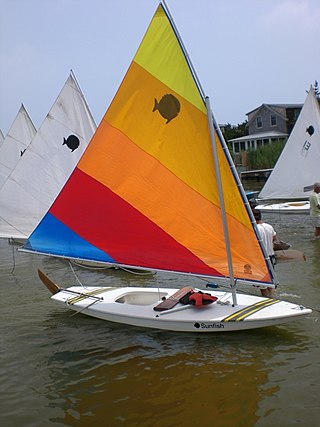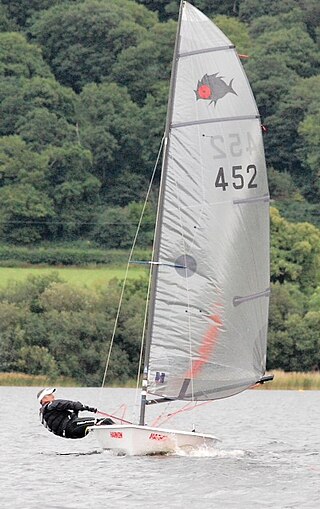
Dinghy sailing is the activity of sailing small boats by using five essential controls:

The Albacore is a 4.57 m (15 ft) two-person planing dinghy with fractional sloop rig, for competitive racing and lake and near-inshore day sailing. Hulls are made of either wood or fiberglass. The basic shape was developed in 1954 from an Uffa Fox design, the Swordfish. Recent boats retain the same classic dimensions, and use modern materials and modern control systems.

The Topper is an 11 foot 43 kg (95 lb) sailing dinghy designed by Ian Proctor. The Topper was a one-design boat until 2023 when a new version was produced, and is sailed mostly around the British Isles. It was recognised as a World Sailing Class. The boat previously constructed from polypropylene, and now roto moulded, is popular as a racing boat or for sail training. The class association (itca) organise racing events, which range from small travellers to major championships. The RYA run squads alongside the events; in these squads young sailors who are given specialist race coaching.

The Sunfish is a personal-size, beach-launched sailing dinghy. It features a very flat, boardlike hull carrying an Oceanic lateen sail mounted to an un-stayed mast.

The OK Dinghy is an international class sailing dinghy, designed by Knud Olsen in 1956.
The Comet, sometimes called the Comet OD or Comet One-Design, is an American sailing dinghy that was designed by C. Lowndes Johnson as a one-design racer and first built in 1932. The design has evolved over time via modifications.
The Rhodes 19 is an American trailerable day sailer or sailing dinghy, that was designed by Philip Rhodes as a one-design racer and first built in 1958.

The Jacksnipe is a two-man racing sailing dinghy with a single trapeze for the crew and symmetrical spinnaker.

The Solution is a single handed hiking dinghy designed for helms in the 65 to 85 kg weight range. It has a light epoxy hull, self draining cockpit, high aspect rig, semi battened 8.5 sq. metre sail, and full complement of dual controls.

The Topper Topaz is a British single-handed or two-handed sailing dinghy that was designed as a beginner and intermediate racer.
The Tech Dinghy is an American sailing dinghy that was designed by George Owen, a professor at Massachusetts Institute of Technology (MIT), as a one-design racer and for sail training. It was first built in 1935.
The Capri Cyclone, also referred to as the Cyclone 13 or just the Cyclone, is an American sailing dinghy that was designed by Frank V. Butler as a one-design racer and first built in 1970.
The Cheshire 14 is an American catamaran sailing dinghy that was designed by Frank Meldau as a racer and first built in 1962.
The US1, sometimes written US 1, is an American sailing dinghy that was designed by Ralph Kuppersmith and Clark Mills as a one-design racer and first built in 1973.
The AMF Apollo 16 is an American sailing dinghy that was designed by Canadian Bruce Kirby as a one-design racer and first built in 1977.
The Leeward 16 is an American sailing dinghy that was designed by Luger Industries and first built in 1962.
The Precision 16 is an American sailing dinghy that was designed by Stephen Seaton and first built in 1982.
The Dolphin 17 is an American trailerable sailboat that was designed by Glenn Corcoran and Murray Corcoran and first built in 1970.
The Transit 380, styled as the Transit_380 or T_380, is an American sailing dinghy that was designed by Jim Taylor for youth sail training and first built in 2005. The boat was intended to act as a "transition" boat between the Optimist dinghy and more high performance boats. The designation indicates the length overall in centimeters.

The Sea Pearl 21 is an American trailerable sailboat or sailing dinghy, that was designed by Ron Johnson as a daysailer and first built in 1982.









